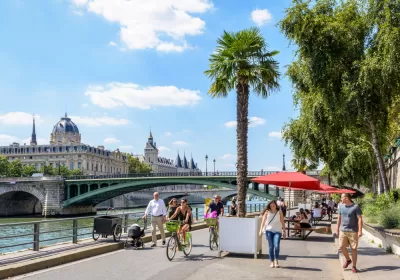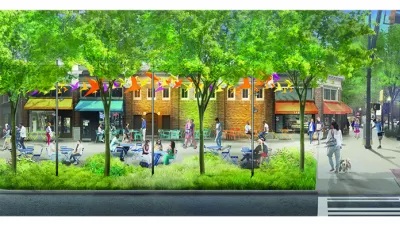The concept, touted as "hyper-local," can fail to take into account local conditions and historical inequities in American cities.

The concept of the "15-minute city" has been adopted as an aspirational buzzword by city leaders across the United States, but "there are dangers of applying a model conceived in Europe to many North American cities," writes Feargus O'Sullivan for Bloomberg CityLab. Urban designer Jay Pitter calls transplanting the idea potentially "presumptive and colonial," arguing that "it doesn't take into account the histories of urban inequity, intentionally imposed by technocratic and colonial planning approaches, such as segregated neighborhoods, deep amenity inequity and discriminatory policing of our public spaces" that are deeply embedded in American cities.
European cities, designed before mass car ownership, are more well-suited to the notion of the 15-minute city, writes O'Sullivan. The lofty goal of creating small neighborhoods where all amenities are within easy reach is "unlikely to reach all neighborhoods in many cities without drastic interventions and investments," and "simply injecting design changes such as bike lanes and parklets into a neighborhood will not reverse segregation that has been embedded into city planning."
The proposals neglect "a century of planning interventions that have actually concretized deep social divisions between people," says Pitter, calling the concept "top-down, technocratic urban planning" rather than a "systematic and holistic approach" that would more carefully consider social relationships and historic inequities. While it claims to be hyper-local, Pitter argues that implementing the approach without consideration to local conditions has the opposite effect.
FULL STORY: Where the ‘15-Minute City’ Falls Short

Alabama: Trump Terminates Settlements for Black Communities Harmed By Raw Sewage
Trump deemed the landmark civil rights agreement “illegal DEI and environmental justice policy.”

Study: Maui’s Plan to Convert Vacation Rentals to Long-Term Housing Could Cause Nearly $1 Billion Economic Loss
The plan would reduce visitor accommodation by 25% resulting in 1,900 jobs lost.

Planetizen Federal Action Tracker
A weekly monitor of how Trump’s orders and actions are impacting planners and planning in America.

This Toronto Suburb Has More Bus Riders Than Columbus, Ohio
Brampton, Ontario used gradual improvements in service to prove that if you build it, they will ride.

Paris Bike Boom Leads to Steep Drop in Air Pollution
The French city’s air quality has improved dramatically in the past 20 years, coinciding with a growth in cycling.

Why Housing Costs More to Build in California Than in Texas
Hard costs like labor and materials combined with ‘soft’ costs such as permitting make building in the San Francisco Bay Area almost three times as costly as in Texas cities.
Urban Design for Planners 1: Software Tools
This six-course series explores essential urban design concepts using open source software and equips planners with the tools they need to participate fully in the urban design process.
Planning for Universal Design
Learn the tools for implementing Universal Design in planning regulations.
Smith Gee Studio
Alamo Area Metropolitan Planning Organization
City of Santa Clarita
Institute for Housing and Urban Development Studies (IHS)
City of Grandview
Harvard GSD Executive Education
Toledo-Lucas County Plan Commissions
Salt Lake City
NYU Wagner Graduate School of Public Service





























